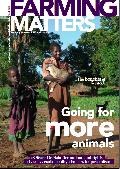One way for “dollar-poor” small-scale farmers to increase their income per hectare is to switch to higher value agricultural products, such as meat, milk or eggs. Stronger engagement in livestock production, however, exposes smallholders to additional risks, such as losing their animals through theft, predation or disease. While farmers’ management practices provide some resilience to common diseases, public interventions are needed to help cope with epidemics.

First, poorer livestock keepers tend to invest in lower value livestock species, such as poultry, pigs, and small ruminants. These have higher reproductive potential than cattle or buffalo and allow relatively rapid restocking after animal losses.
Second, smallholders tend to keep locally adapted varieties, with an innate or acquired resistance to endemic disease agents. These varieties are not only stronger, but also fetch higher prices on local markets due to the taste and texture of their products.
Third, inputs into livestock production, such as concentrate feed, mineral supplements, vaccines or other prophylactics, are kept to a minimum. The farmer will only use such inputs if he has personal experience of the benefits outweighing the costs (for example, few farmers vaccinate their poultry against Newcastle disease, even when the vaccine is available).
These management practices ensure that the smallholder livestock “enterprise” is relatively resilient against commonly occurring, endemic diseases. When catastrophic stock losses appear, informal safety nets within the community will normally provide seed stock for the unfortunate livestock keeper to restock.
But these strategies fail in the face of epidemic diseases, to which local livestock breeds have not been previously exposed and to which they are just as vulnerable as high potential exotic breeds. In the case of epidemics, the livestock pool of an entire community may be depleted and thus intra-community safety nets fail. Of particular danger in this situation are distress sales, through which disease is easily spread to neighbouring communities. This combination of production shock and negative externality is unique to highly contagious animal diseases and needs to be addressed by public interventions that combine prevention, insurance and compensation for negative impacts of disease control activities.
Text: Joachim Otte
Joachim Otte is co-ordinator at Pro-Poor Livestock Policy Initiative at the Food and Agriculture Organization of the United Nations (FAO), Rome.

